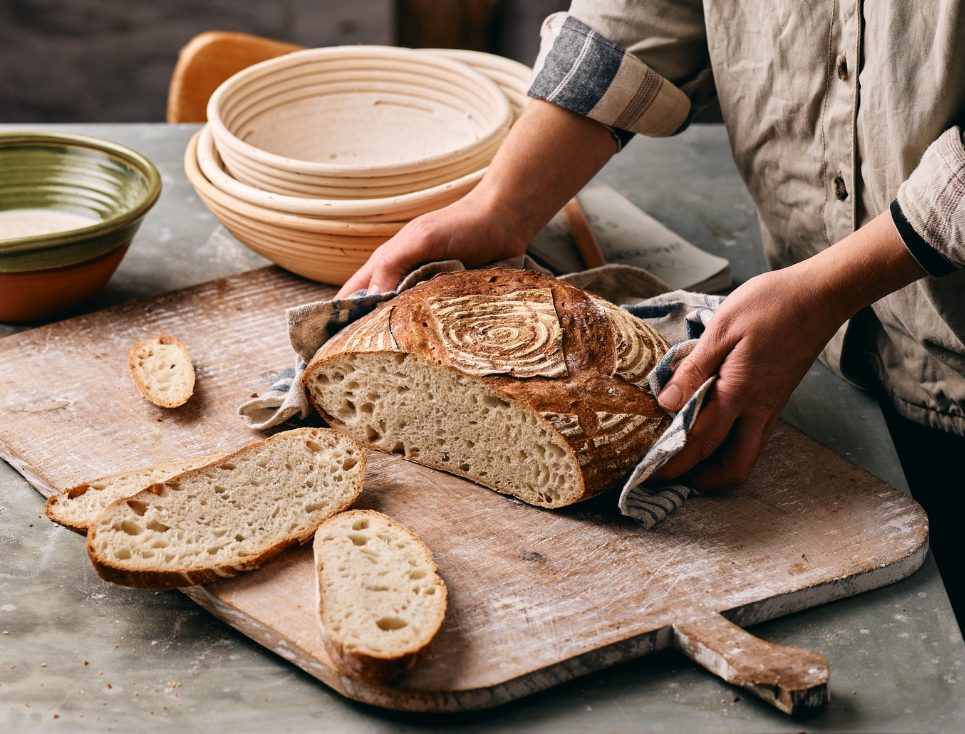
White Sourdough Bread – 123 Method
An established sourdough starter is required for this white sourdough bread recipe. It should have a flour and water feed about 12 hours before you are going to bake so that it is active and lightly bubbly. We call this the 1,2, 3 method because you weigh one quantity of active starter, double that weight for the amount of water and triple that weight for the flour. Choose the small or large quantities below depending on the size of loaf you want to bake. The dough will be very sticky at first and a plastic dough scraper or tablespoon are needed to help lift and stretch the dough. Bake at the hottest temperature.
Ingredients
STEP 1
- 100g/200g sourdough starter
STEP 2
- 200g/400g water
STEP 3
- 300g/600g Wessex Mill Strong White Bread Flour
- plus ½ tsp / 1 tsp salt
- plus oil, for hands
- plus flour, for banneton
Equipment
- 2 x mixing bowls
- 1 x banneton
- 1 x clean tea towel
- 1 x dough scraper
Method
240˚C, Fan 220˚C, 475˚F, Gas 9 (use highest bread setting if available)
-
Choose the small or large loaf quantities, weigh the starter into a large mixing bowl, mix in the water and stir until it is dispersed.
-
Add the flour and mix into a sticky dough. Cover the bowl with a damp tea towel to prevent a skin from forming on the dough and rest for 30 minutes.
-
Sprinkle the salt over the top and mix thoroughly to ensure the salt is dispersed throughout the dough. The dough scraper can be helpful to do this.
-
Now perform the first set of stretch and folds which will help form the dough structure. To do this loosen the dough from the edges of the bowl with a tablespoon or dough scraper. Then lift up one side of the dough and fold it back on itself. Rotate the bowl 90 degrees and repeat the lifting and folding over four or five times. Cover the bowl and leave for 30 minutes.
-
Perform 3 more sets of big dough lifts, stretch and folds, 30-60 minutes apart. In between leave the bowl covered with the damp tea towel at room temperature.
-
After the final stretch and fold, cover and leave the dough to rest for 2 hrs.
-
Dust the banneton liberally with flour.
-
Turn the dough out onto a well-floured surface, dust it with flour and gently flatten the dough with the heal of your hand. You may hear some air escaping as you do this. Then pull in the corners of the dough into the middle and turn the ball of dough over. Run both your hands under the dough palm side up so that they meet underneath, bringing the dough into ball with the seal at the bottom.
-
Place the dough in the banneton with the rounded side facing down. Alternatively line a clean mixing bowl with a tea towel and dust it heavily with flour before placing the dough inside.
-
Cover with the damp tea towel and leave for 4 – 8 hours until the dough has risen. Timing can vary depending on the activity of the starter, the dough temperature and the room temperature. OR leave in a cool place overnight and allow it to come back to room temperature in the morning before proceeding.
-
Preheat the oven when you are getting ready to bake.
-
Gently turn the dough out of the banneton onto a baking tray. If you like at this stage, you can take a very shape knife and carefully score a pattern in the top of your loaf creating a pattern.
-
Bake for 35-40 minutes for a small loaf, 40-45 for a large loaf. The bread is done when it’s golden brown in colour. When you tap it underneath it should sound hollow.

